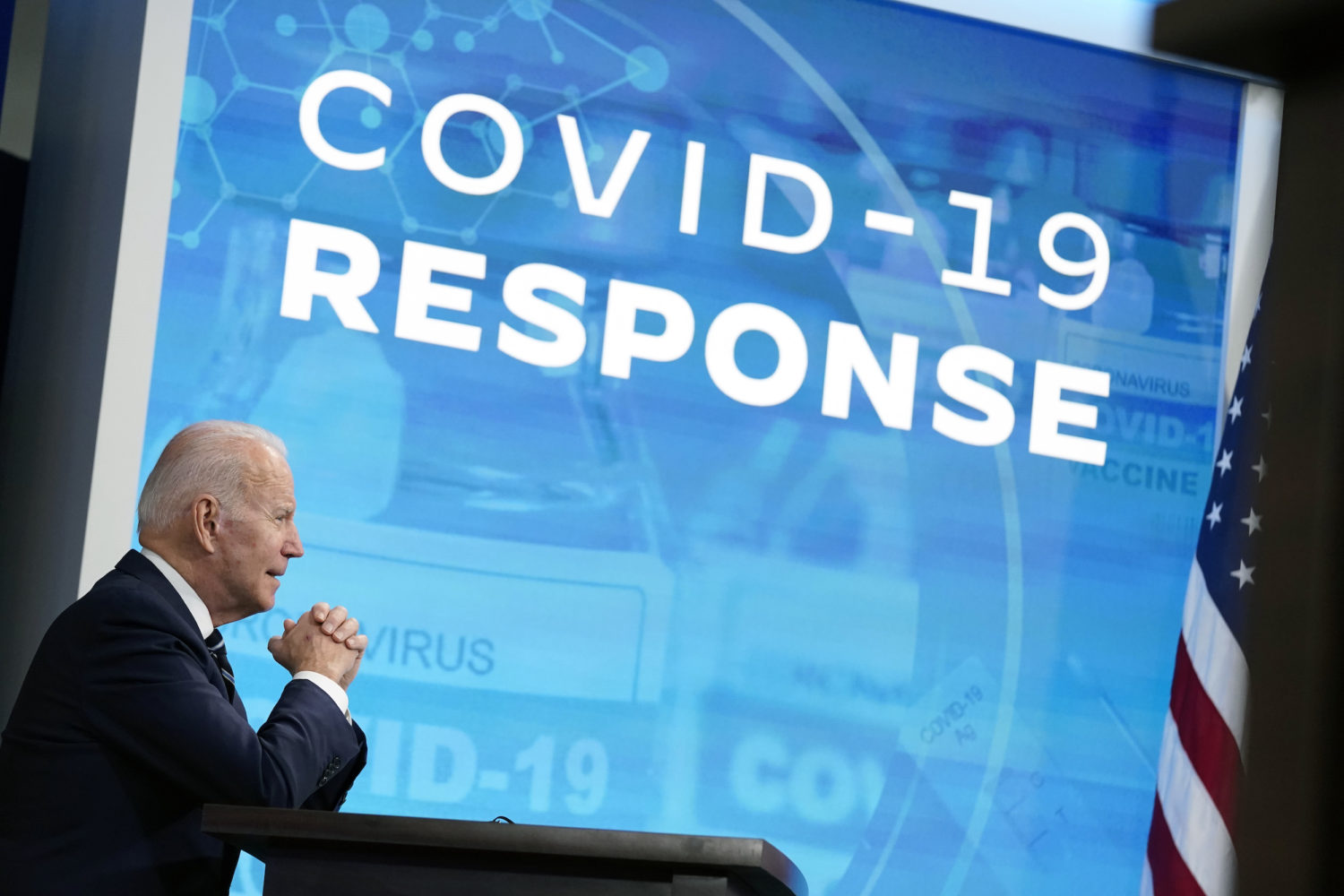 Covering COVID-19 is a daily Poynter briefing of story ideas about the coronavirus and other timely topics for journalists, written by senior faculty Al Tompkins. Sign up here to have it delivered to your inbox every weekday morning.
Covering COVID-19 is a daily Poynter briefing of story ideas about the coronavirus and other timely topics for journalists, written by senior faculty Al Tompkins. Sign up here to have it delivered to your inbox every weekday morning.
It might be tempting for President Joe Biden to declare victory over COVID-19 in his State of the Union speech tonight, but that would be premature. He can, however, claim progress.
The Centers for Disease Control and Prevention just released most of the United States from mask-wearing but, by its original metrics, most of America still has a high rate of COVID-19 transmission. Members of Congress will sit maskless in front of the president, some of them applauding, some not, but the visual message if they were masked would be that the pandemic remains in full bloom.
And, as the president stands before Congress, he cannot avoid the fact that a staggering 947,000 people have died of COVID-19 in the United States. The number of people dying each day today is nearly exactly what it was on this date a year ago.
The big difference is that the number was rising fast a year ago, and it is falling just as fast now and, still, more than 1,800 people are dying from COVID-19 every day.
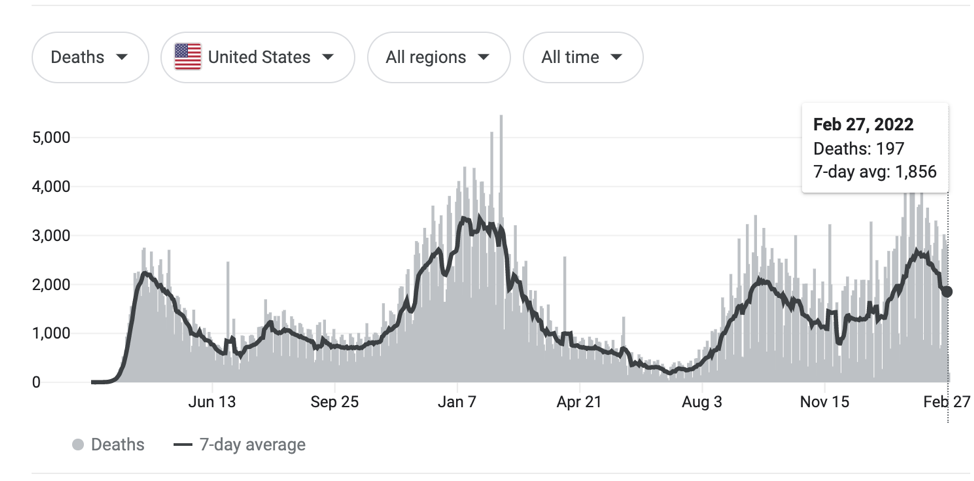
(Johns Hopkins)
Before he took office, Biden issued a 200-page plan to manage COVID-19. He laid out seven goals. The No. 1 goal was to “restore trust with the American people.” But mistrust in the vaccine’s safety remains a key concern for parents who are reluctant to vaccinate children and teens.
The new Marist/PBS NewsHour poll shows how Americans assess Biden’s handling of the pandemic. Democrats and Republicans are nearly mirror images of each other in approval and disapproval of the president’s performance.
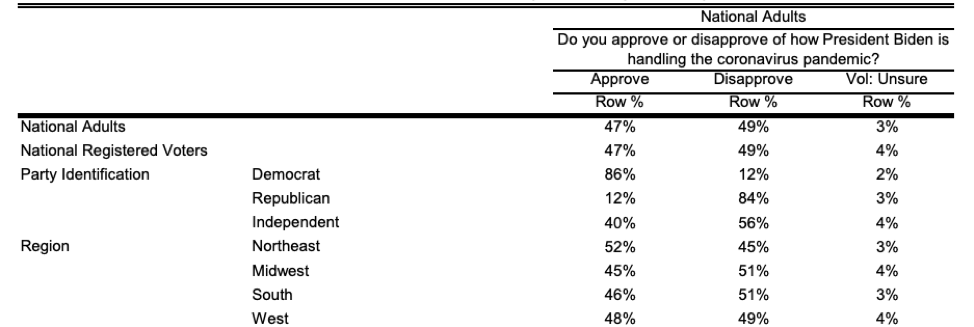
(Marist, February 2022)
FiveThirtyEight combined a range of polls — some Democrat-leaning, some Republican-leaning and some centrist — that show Biden’s approval ratings declining steadily since he was sworn in, with a 69% approval rating of his plan to handle the pandemic.
A key element of that effort was his plan to put into place “predictable and robust” federal purchasing of coronavirus tests, which took a year to hit people’s mailboxes. By then, two variants had roared through the country.
He promised to boost staffing in nursing homes. Today, nursing homes say they are woefully understaffed. In New Jersey, the National Guard was called in to help with duties. Some nursing homes closed wings and cut the number of new patients they accept. But as NPR reports:
A recent industry report estimated that nursing homes and assisted living facilities together have lost more than 250,000 jobs since the start of the pandemic. And an analysis by the Kaiser Family Foundation suggests the industry has continued to have problems employing people while other health service industries have recovered in the past year or so.
However, the industry’s staffing issues didn’t start with COVID.
“We know that even before the pandemic, two years ago, there were already staff shortages,” says the AARP’s Reinhard. “It’s a perennial problem.”
Jeff Zients, the president’s coronavirus response coordinator, said while the administration is proud that a half-billion doses of the COVID-19 vaccine have been administered, parts of the country have remained stubbornly unvaccinated. Zients said, “We underestimated in that original strategy … the amount of disinformation and the fact that people would actually stand in the way of the pandemic response for political or other motivations.”
Here are the numbers as we approach the State of the Union address:

(Our World in Data)
Here are the most vaccinated states:
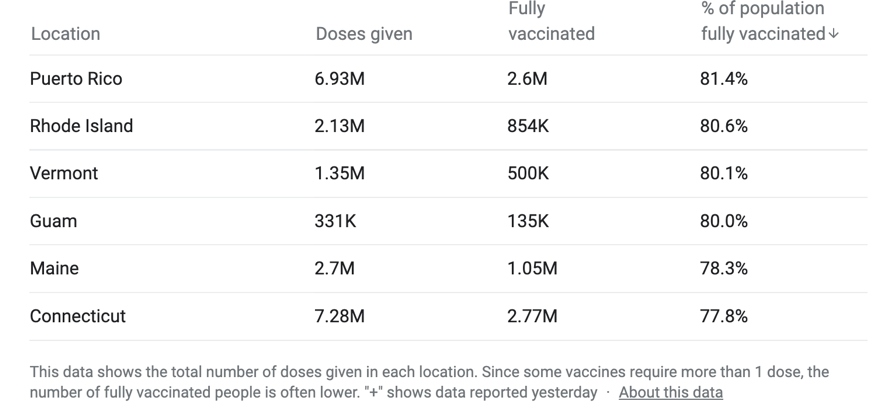
(Our World in Data)
And here are the least vaccinated states:
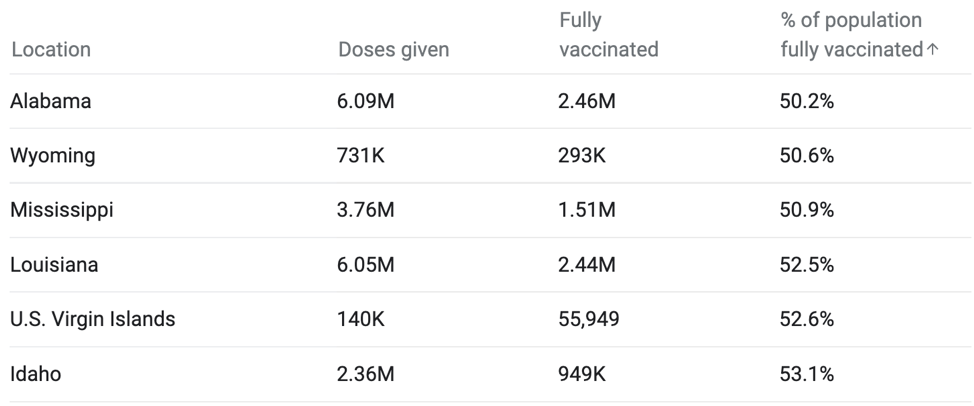
(Our World in Data)
If you drill deeper, you will find big spikes in new cases in some of the least vaccinated areas. Again, it underscores the doubling and even tripling of new cases in some places in the last week.
Biden can truthfully point out that his administration “took steps to make vaccines available at over 80,000 locations nationwide, worked with pharmacies to offer walk-in appointments.” Biden mandated federal employees, including the military, to be vaccinated. He tried but failed to get court approval for a federal mandate requiring companies with 100 or more employees to require vaccinations or routine testing.
Upon taking office, Biden promised to “restore U.S. leadership globally and build better preparedness for future threats.” But even the president admits that the government missed an opportunity to corral the latest COVID-19 outbreak by not launching a national testing program faster.
The state of hospitals and health care
The State of the Union speech will not likely speak to the fragility of our health care system, but it should. The pandemic magnified a national nursing shortage that is growing worse.
When he took office, the president promised, “As we work to reduce cases, hospitalizations, and deaths, we will maintain our focus on treating people infected with COVID-19 — and helping hard-hit health care systems in the most impacted areas.”
How big is the problem? This is Department of Health and Human Services data:
The American Association of Colleges of Nursing says it could educate more nurses, but it doesn’t have the infrastructure to do so:
U.S. nursing schools turned away 80,407 qualified applicants from baccalaureate and graduate nursing programs in 2019 due to insufficient number of faculty, clinical sites, classroom space, and clinical preceptors, as well as budget constraints. Almost two-thirds of the nursing schools responding to the survey pointed to a shortage of faculty and/or clinical preceptors as a reason for not accepting all qualified applicants into their programs.
Another thing the president probably won’t get around to in his speech — but should — is that the country is losing its rural hospitals. They have been losing money for years and were closing before Biden took office, but the pandemic added new pressure. The National Rural Health Association estimates that 453 rural hospitals, or about a quarter of the total, are at risk of closure. Federal aid packages are keeping many of them afloat, but when funding runs out next year, they will be back again on the financial bubble.
Biden may also claim credit for an increased number of Americans covered under the Affordable Care Act. New HHS data says the percentage of Black Americans who lack medical insurance has dropped substantially under the ACA. HHS says a million more Black Americans could qualify for health insurance if a dozen states that have not expanded Medicaid coverage under ACA would do so.
The State of the Union for schools during the pandemic
Biden pushed for and secured $130 billion in the American Rescue Plan for schools to reopen and address inequities that arose during remote learning. A Washington Post story summarizes the challenges ahead for schools, some of which government spending programs won’t fix. Keep in mind, Biden inherited a national school lockdown that was entering its second year. The Post story begins this way:
Test scores are down, and violence is up. Parents are screaming at school boards, and children are crying on the couches of social workers. Anger is rising. Patience is falling.
For public schools, the numbers are all going in the wrong direction. Enrollment is down. Absenteeism is up. There aren’t enough teachers, substitutes or bus drivers. Each phase of the pandemic brings new logistics to manage, and Republicans are planning political campaigns this year aimed squarely at failings of public schools.
Public education is facing a crisis unlike anything in decades, and it reaches into almost everything that educators do: from teaching math, to counseling anxious children, to managing the building.
Political battles are now a central feature of education, leaving school boards, educators and students in the crosshairs of culture warriors. Schools are on the defensive about their pandemic decision-making, their curriculums, their policies regarding race and racial equity and even the contents of their libraries. Republicans — who see education as a winning political issue — are pressing their case for more “parental control,” or the right to second-guess educators’ choices. Meanwhile, an energized school choice movement has capitalized on the pandemic to promote alternatives to traditional public schools.
As the Post points out, national i-Ready test scores show, ”In fall 2021, 38 percent of third-graders were below grade level in reading, compared with 31 percent historically. In math, 39 percent of students were below grade level, vs. 29 percent historically.”
Look at this concerning data showing how students are performing in elementary math and reading. First, the math scores:
The i-Ready tests show only one in four fifth graders tested on grade level in the fall of 2021. That is a 10% drop. Fourth graders and sixth graders also dropped by a lot.
Reading scores were not quite as low but they dropped 6% for second graders last year.
Becky Pringle, president of the National Education Association, said, “The pandemic made an already dire reality even more devastating.” Burned out teachers quit, creating a severe shortage.
The Biden administration has some wins it could point to. For example, the Department of Education says:
- Colorado is using American Rescue Plan money to encourage people to join the teaching profession and mentor those who are new to teaching.
- South Carolina hired new college graduates to work as summer teaching interns to help students catch up after losing out on learning while attending class remotely.
- A school system in Montana used American Rescue Plan dollars to give $1,500 stipends to educators and other school employees.
- North Dakota used $7 million in American Rescue Plan funds to offer preschool to 4-year-olds.
- Dayton, Ohio, used American Rescue Plan allotments to hire math specialists for elementary schools.
- Using American Rescue Plan funds, “Arkansas created the Arkansas Tutoring Corps, which includes recruitment, preparation, and support for candidates to become qualified tutors to provide instruction or intervention to meet the academic needs of at-risk learners or students most impacted by lost instructional time.”
- Data tracked by Burbio show more than 40% of districts plan to spend American Rescue Plan funds on HVAC improvements.
- Tennessee expects to use the funds to provide tutoring for 240,000 students “who lost instructional time from the pandemic.”
You can go here to see fact sheets for each state’s plans for American Rescue Plan funds that outline how each state will or has spent funds.
Has the public moved on from the pandemic to the economy?
The economy and the pandemic are, of course, intertwined. During the Biden administration, the country added 6 million jobs and the unemployment rate is at historic lows. But supply chain interruptions coupled with federal stimulus dollars that gave ordinary folks more buying power produced an imbalance in supply and demand and prices on everything from food and gasoline to rent and used cars soared.
New PBS NewsHour/Marist polling (which was done before the Russian invasion of Ukraine) shows that the public is moving on from the pandemic and is intensely focused on inflation as the top issue facing the country.
A plurality of Americans (38%) thinks President Biden’s top priority should be inflation. The coronavirus pandemic (11%), voting laws (11%), foreign policy (10%) and violent crime (10%) follow. Other issues receive single digits. Of note, more than seven in 10 Americans (72%) are optimistic that the nation is nearing an end to the coronavirus pandemic.
The Biden administration will claim credit for the fact that small business start-ups have soared during the pandemic.
Illinois, Mississippi, Georgia, South Carolina, Louisiana, Alabama, Wyoming and Delaware all saw small business startups at a rate that significantly eclipse 2019 levels.
In the chart below, the bigger and darker blue the dot is, the more that state grew its number of small businesses during the pandemic:
Track the claims
My colleagues at PolitiFact collect the promises that Biden makes and follow the progress of those promises, just as they did for Presidents Barack Obama and Donald Trump.
They will be fact-checking the Statue of the Union as well.
We’ll be back tomorrow with a new edition of Covering COVID-19. Are you subscribed? Sign up here to get it delivered right to your inbox.

